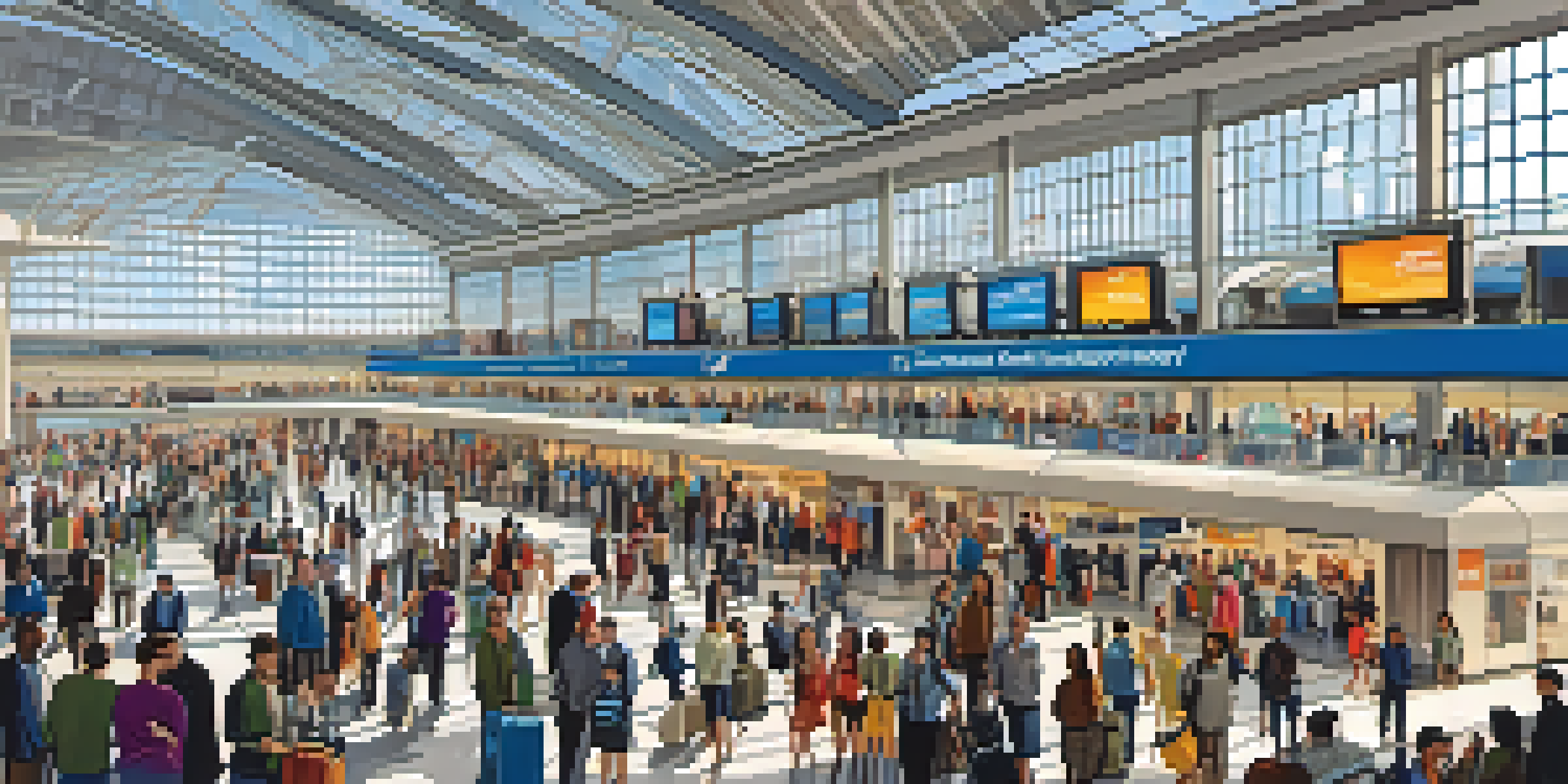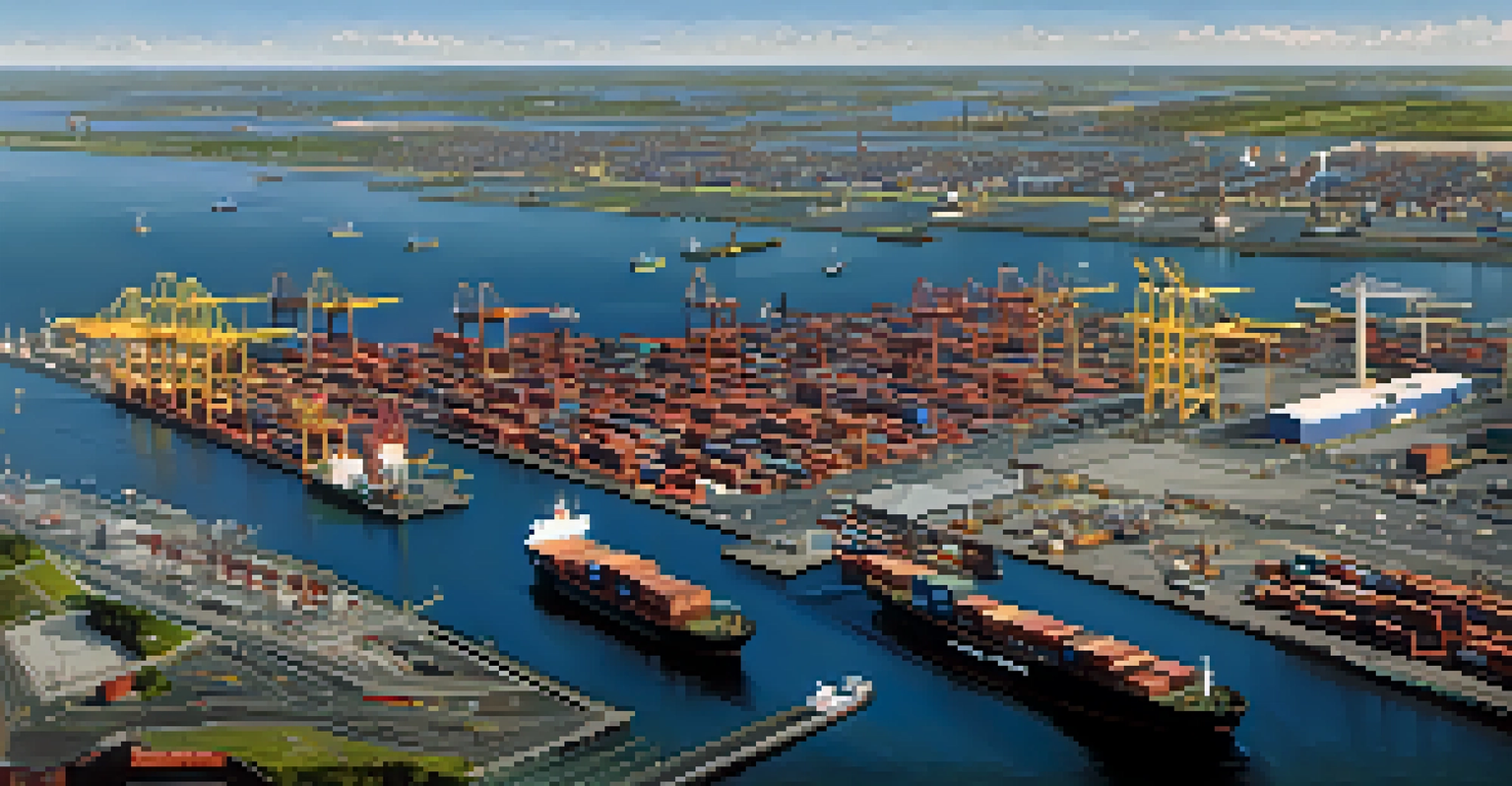Newark as a Transportation Hub: Connecting the Region

Newark's Strategic Location: A Gateway to the East Coast
Newark is uniquely positioned in New Jersey, making it a central hub for transportation. With its proximity to major cities like New York City and Philadelphia, it serves as a gateway for both commuters and travelers. This strategic location means that Newark is not just accessible, but also a vital point of connection for various transport networks.
Transportation is the backbone of a community's economy and quality of life.
Being located near the confluence of several major highways and rail lines, Newark allows for seamless travel across the East Coast. It connects to I-95, I-78, and the New Jersey Turnpike, facilitating easy access for vehicles. Additionally, the Newark Penn Station is a critical stop for Amtrak and NJ Transit, making it a key player in regional rail transport.
This advantageous position enhances Newark’s role as a transportation hub, drawing in businesses and travelers alike. With its blend of road and rail connections, Newark isn’t just a stop along the way; it’s a destination in its own right.
Newark Liberty International Airport: A Major Air Travel Hub
One of Newark's standout features is the Newark Liberty International Airport, one of the busiest airports in the country. It serves millions of passengers each year, providing vital connections to domestic and international destinations. The airport's extensive network makes it a crucial asset for both travelers and airlines.

With multiple airlines operating from its terminals, Newark Liberty offers a diverse array of flight options. This airport not only facilitates convenient travel but also boosts the local economy by creating jobs and attracting tourism. The modern amenities and services available cater to the needs of business and leisure travelers alike.
Newark: A Transportation Hub
Newark's strategic location and extensive transport networks make it a vital connection point for commuters and travelers across the East Coast.
Moreover, the airport’s integration with local transportation services, like the AirTrain, makes getting to and from the airport easy and efficient. This seamless connection reinforces Newark’s status as a transportation hub, ensuring that people can travel without hassle.
The Role of Public Transit in Newark's Transportation Network
Public transit is a cornerstone of Newark's transportation infrastructure, making it easier for residents and visitors to navigate the city. The extensive NJ Transit system, which includes buses and trains, connects Newark to various parts of New Jersey and beyond. This reliable service is essential for commuters heading to work or school each day.
A strong public transit system is vital for economic growth and environmental sustainability.
Additionally, the city is served by several light rail lines, such as the Newark Light Rail, which provides convenient access to key neighborhoods and attractions. These transit options not only enhance mobility but also promote sustainability by reducing reliance on personal vehicles. It’s a win-win for the environment and the community.
With ongoing investments in public transit, Newark is committed to improving its transportation services. This focus on enhancing accessibility will ensure that the city remains a vital hub for transportation in the region, making it easier for everyone to get around.
Bicycle and Pedestrian Infrastructure: Supporting Alternative Travel
Newark is increasingly prioritizing bicycle and pedestrian infrastructure to promote alternative modes of transportation. With bike lanes and pedestrian-friendly streets, the city encourages residents to opt for cycling or walking, reducing traffic congestion and pollution. This initiative supports a healthier lifestyle while also enhancing the urban environment.
The Newark Bike Share program is one example of how the city is making cycling more accessible to its residents. With numerous bike stations across the city, people can easily rent bicycles for short trips, creating a more connected community. This program not only fosters a culture of cycling but also helps integrate biking into the overall transportation network.
Air Travel Boosts Local Economy
The Newark Liberty International Airport serves millions of passengers annually, providing essential domestic and international connections that stimulate the local economy.
Furthermore, the city’s focus on enhancing public spaces for pedestrians reflects a commitment to inclusivity. By creating safe and welcoming environments for walking, Newark is not just improving transportation options; it’s enhancing the quality of life for all its residents.
Freight and Cargo: Newark's Economic Backbone
Newark plays a pivotal role in freight and cargo transport, serving as a crucial link in the supply chain. The Port of Newark, part of the larger Port Authority of New York and New Jersey, is one of the busiest ports in the United States. This facilitates the movement of goods not only locally but also globally, reinforcing Newark's importance as a transportation hub.
The extensive road and rail networks surrounding the port allow for efficient distribution of cargo throughout the region. This connectivity benefits businesses by reducing transit times and costs, making Newark an appealing location for logistics companies. The economic impact of this freight activity is significant, contributing to job creation and local business growth.
Moreover, as e-commerce continues to rise, Newark's freight infrastructure is adapting to meet the increasing demand for quick delivery services. Investments in logistics technology and facilities are positioning Newark to remain a leader in freight transport for years to come.
Community Engagement: Shaping Newark's Transportation Future
Community engagement is vital in shaping the future of Newark's transportation landscape. City planners actively seek input from residents to understand their needs and preferences, ensuring that transportation projects align with community goals. This inclusive approach fosters a sense of ownership and pride in the city's development.
Town hall meetings, surveys, and workshops provide platforms for residents to voice their opinions on transportation issues. By involving the community in the decision-making process, Newark can create solutions that truly benefit its citizens. This collaboration is essential for building a transportation system that is efficient, equitable, and sustainable.
Community Engagement in Transit
Active community involvement in transportation planning ensures that Newark's infrastructure aligns with the needs and preferences of its residents.
Furthermore, community-driven initiatives, such as local transit advocacy groups, play a crucial role in raising awareness about transportation challenges and opportunities. This grassroots involvement helps to ensure that Newark's transportation infrastructure evolves in a way that reflects the values and needs of its diverse population.
Future Developments: Enhancing Newark's Transportation Network
Looking ahead, Newark is poised for exciting transportation developments that will further cement its status as a regional hub. Ongoing infrastructure projects aim to modernize existing transit systems and introduce new technologies to improve efficiency. These developments not only enhance connectivity but also aim to create a more user-friendly experience for travelers.
For instance, plans for expanded rail services and improved bus routes are in the works, promising to make commuting more convenient. Moreover, Newark is exploring innovative solutions like smart traffic management systems to ease congestion and improve travel times. These advancements reflect a commitment to adapting to the changing needs of the community.

As Newark continues to evolve, the focus remains on creating an integrated transportation network that supports economic growth and quality of life. By investing in future developments, Newark is not just planning for tomorrow; it’s laying the groundwork for a vibrant, connected community.